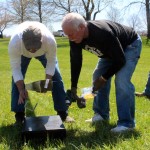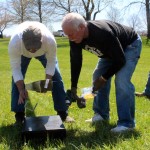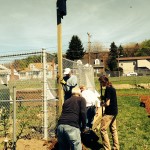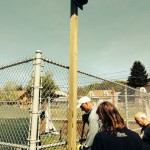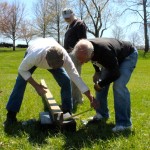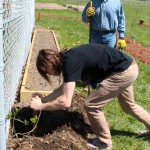Master Gardeners, our local Penn State Extension Agent, and IUP students worked together to install our first bat house. The house was purchased from the Organization for Bat Conservation. It is designed to absorb heat, provide proper ventilation and house up to 300 bats. Bats help humans by eating mosquitoes, destroying insects that eat crops, and pollinating fruits and nuts. They also help spread seeds in the rain forest in tropical climates.
This bat house can hold up to 300 insect-eating bats!
5 things to know about bats
Bats eat lots of bugs.
Bats control populations of beetles, moths, leafhoppers and other crop and garden pests. The bats in a single bat house can prevent more than 33 million rootworm infestations over the course of a single summer. The agricultural pest control services provided by bats in the USA has been estimated at 4 and 50 billion dollars a year.
Bats are not dangerous
There are many myths about bats. They are not aggressive and do not get tangled in hair. Like all mammals, bats can contract rabies. Never touch a bat. Although rabies is rare in bats, if you see a bat up close- do not touch it!
Bats are diverse
There are 1,200+ species of bats, making up about 25% of all mammals. Pennsylvania has 11 species, which all eat insect pests. The largest bat in PA is the Hoary Bat, which weighs up to 1.5 ounces and has beautiful multi-colored fur. The small tricolored bat (seen above) weighs only a bit more than a nickel. The red bat is bright orange and migrates south for the winter.
Bats are fascinating
Bats are social and intelligent animals. All Pennsylvania bats use sophisticated biosonar to find insects in the dark. Most bats eat insects, but other bats around the world feed on fruit, nectar, and even other animals like fish. Bats are important pollinators and seed dispersers.
Bats are in trouble
Bats are being extirpated from Eastern North America by an invasive fungus called White-nose Syndrome that first appeared in the USA in 2007. The epidemic is considered the worst wildlife disease outbreak in North American history. The Pennsylvania Game Commission estimates a “99% decline overall” in bat populations because of the disease.
For more information:
Bat Conservation International (www.batcon.org)
Organization for Bat Conservation (www.batconservation.org)
Bat Conservation and Management (www.batmanagement.com)
Slideshow for pictures of the installation of the bat house





